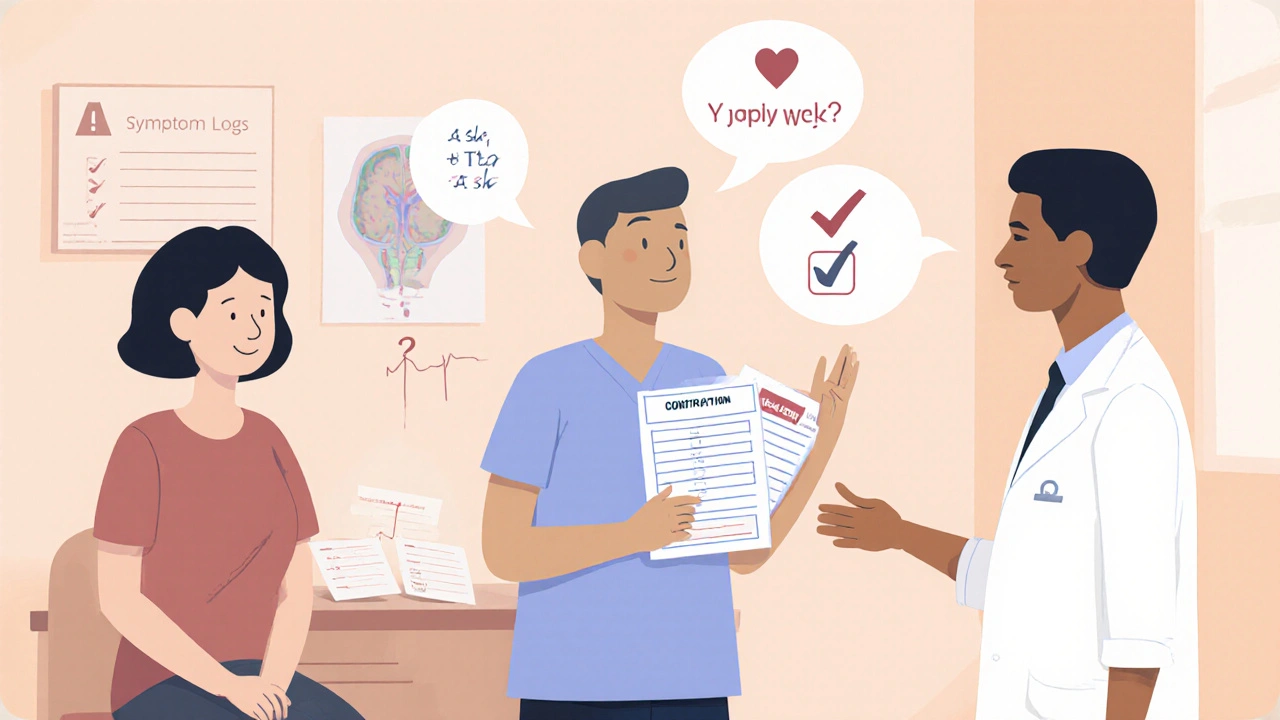SPMS Symptom Tracker
Track your symptoms to prepare for appointments and advocate for better care.
Add New Symptom Entry
Your Symptom Entries
No entries yet. Add your first symptom entry above.
Living with secondary progressive multiple sclerosis is a daily balancing act-your body may be changing, but you still want to stay in control of your care. self advocacy isn’t a buzzword; it’s the practical toolbox that lets you get the right treatment, the right support, and the respect you deserve.
Quick Takeaways
- Write down symptoms, questions, and goals before every visit.
- Know your rights: disability benefits, reasonable accommodations, and insurance appeals.
- Use a mix of direct conversation, written summaries, and a trusted supporter.
- Leverage patient‑advocacy groups for up‑to‑date research and legal help.
- Track outcomes and adjust your strategy every 3-6 months.
1. Know What "Active" Means for Your Disease
When doctors say your SPMS is "active," they’re referring to ongoing inflammation or new lesions that can still respond to disease‑modifying therapies. This is different from a purely degenerative phase where options are limited. Understanding that nuance helps you argue for continued DMTs (disease‑modifying treatments) instead of settling for symptom‑only care.
To solidify this point, bring recent MRI reports, relapse records, and any lab trends to the appointment. A concrete data packet turns a vague impression into a medical fact that your neurologist can’t easily dismiss.
2. Prepare Like a Pro for Every Appointment
Preparation is the backbone of advocacy. Follow this checklist:
- Symptom Log: Record the date, time, severity (1‑10), triggers, and how each symptom affects daily life.
- Medication Review: List every pill, dose, timing, side effects, and adherence challenges.
- Goal Sheet: Whether it’s reducing fatigue, improving walking distance, or getting a cortisone shot, write it in one sentence.
- Question Bank: Draft 3‑5 concise questions-avoid "Can you explain my MRI?" and aim for "Based on these new lesions, would switching to drug X improve my relapse rate?"
- Support Person: Invite a family member or trusted friend who can echo concerns if you get flustered.
Print this packet, hand it to the care team, and keep a copy for yourself.

3. Communicate Effectively During the Visit
Even the best‑prepared packet can get lost if the conversation spirals. Use the "Ask‑Tell‑Ask" technique:
- Ask: Start with your top question.
- Tell: Share your symptom log and goals, linking each to a specific need (e.g., "My fatigue spikes after 30 minutes of walking, so I need a strategy to stay active.")
- Ask again: Confirm understanding-"Does that mean we’ll try medication Y or a physical‑therapy plan?"
If the doctor uses jargon, pause and ask for plain language. You have the right to fully understand any recommendation before signing a consent form.
4. Leverage Resources and Legal Rights
Self‑advocacy extends beyond the exam room. Here are three pillars you should tap:
| Method | When to Use | Pros | Cons |
|---|---|---|---|
| Direct Conversation | Routine visits, quick decisions | Immediate feedback, builds rapport | May be missed if you’re nervous |
| Written Summary | Complex requests, insurance appeals | Creates a paper trail, reduces misinterpretation | Time‑consuming to draft |
| Third‑Party Support | When physicians are unresponsive or policies block care | Adds credibility, legal weight | May involve fees or paperwork |
For disability benefits, start with the Social Security Administration guidelines on "multiple sclerosis". Keep a copy of your physician’s letters, MRI reports, and a detailed functional‑impact statement. If an initial claim is denied, you have 60 days to request a reconsideration-use the Written Summary method to craft a compelling appeal.
Patient‑advocacy groups like the National Multiple Sclerosis Society offer free legal clinics, up‑to‑date research alerts, and local support meetings. Joining a local chapter gives you a network of people who have already navigated insurance hurdles, medication switches, and workplace accommodations.
5. Manage Common Roadblocks
Even with a solid plan, you’ll hit snags. Here’s how to stay ahead:
- Insurance delays: Call your insurer’s “medical review” line within 48hours of a denied claim. Reference the exact policy clause and ask for a written explanation.
- Physician turnover: Request a copy of all recent notes and imaging before the transition. Use the written summary to introduce yourself to the new doctor.
- Fatigue during appointments: Schedule morning slots, request a short break halfway, or ask for a virtual follow‑up if you’re too tired to stay.
- Information overload: After each visit, summarize the key decisions in a one‑page “Next Steps” sheet. Share this with your support person and add it to your electronic health record (EHR) portal.
6. Action Checklist - Your 3‑Month Advocacy Sprint
- Week1: Gather all recent MRIs, lab results, and medication lists.
- Week2: Draft a symptom log template and start filling it daily.
- Week3: Contact a local MS advocacy group; attend a virtual Q&A.
- Week4: Schedule a pre‑visit call with your neurologist’s nurse to confirm which records they need.
- Month2: File any pending disability benefit appeals using the written summary template.
- Month3: Review your goals, update the symptom log, and adjust your treatment plan with the care team.
Repeating this cycle every quarter keeps your voice loud, your records clean, and your treatment aligned with the evolving nature of active SPMS.

Frequently Asked Questions
How often should I see my neurologist if my SPMS is active?
Most clinicians recommend a visit every 3-6 months when disease activity is documented. If you experience a new relapse or MRI changes, request an earlier appointment.
Can I get a second opinion on a proposed medication change?
Absolutely. Insurance usually covers a second opinion if it’s for the same condition. Use your symptom log and MRI reports to make the new doctor’s review as efficient as possible.
What documentation is needed for a Social Security disability claim?
You’ll need: a physician’s detailed letter citing diagnosis, disease‑modifying therapy history, MRI findings, functional‑impact narrative, and any hospital records of relapses.
How can I make my EHR portal more useful for advocacy?
Upload your symptom log as a PDF, flag new lab results, and use the portal’s messaging function to send brief, documented queries to your care team.
Is it worth hiring a professional patient advocate?
If you face repeated insurance denials, complex legal paperwork, or need workplace accommodations, a professional advocate can streamline the process and increase success rates.


